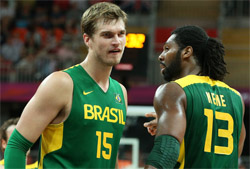When you ask yourself which national men’s basketball team has the best set of bigs, a few names come to mind. Spain, boasting the Gasol brothers, is considered (and rightfully so) to be the best example. Russia has a competent front line too, Turkey as well. Here’s a much more interesting team in this mold: Brazil.
Brazil’s formidable group of big men includes Washington Wizards Forward Nene, San Antonio’s Thiago Splitter, and Cleveland’s Anderson Varejao. Anchor that front line with a point guard as intelligent as Marcelo Huertas, and you’d think this team would be built on a more conservative post-emphasized game. Heck, I did.
Instead, what you get is a race to the basket that seems collaborative and competitive all at the same time. There are three yellow jerseys sprinting to that hoop, and I can’t tell you if the back of the winner’s jersey is going to read “Barbosa”, “Garcia”, or…what the hell’s a “Splitter”? Goodness, they can run!
Brazil’s offense has evolved into a difficult combination of former Argentina coach Ruben Mangano’s hard-nosed post play and head-turning speed. There are several keys to Brazil’s success as a basketball team but it all boils down to this: Tempo.
In fact, Brazil can drive teams mad with their constant switching of tempo. The often unsung characteristic of Brazil’s three premiere bigs is that they run the floor. Nene is an athletic specimen, Splitter- if nothing else- is mobile, and Varejao is all over the place. What is most interesting is that they combine their ability run with an affinity for post-play. Nene has a utility belt of post moves, Splitter is learning quickly how to use his long frame, and Varejao has this agitating ability to draw contact in the paint. Let’s not forget, all three are solid finishers.
Though the work of Brazil’s big men is crucial, it’s the work of their two most talented guards that makes this team so, very, very interesting.
On one hand, there’s Huertas, with his calm, sharp approach to the back court. “Marcelinho” presents a knowledge of the game that puts confidence in Mangano, not to mention Brazilian fans. He is very capable of creating a fast break, materializing scoring chances in a matter of seconds. But, he’s also smart enough to slow the game down, clear a side, and let Nene work on the block. Though he possesses an unorthodox shot (often, Huertas shoots off of one foot, the wrong one), he’s a coach’s favorite player. The true point guard.
Check out Huertas’ performance in exhibition against team USA:
On the other hand, there’s a more one-dimensional Leandro Barbosa. Though a talented scorer, Barbosa is not one for the half court game. The speedy guard works best off of fast-break, up-tempo basketball. The advantage of this is that Barbosa and bring his team back to competing in a game in a hurry, scoring points with speed. But, as quickly as he can bring his team back, Barbosa can just as quickly and easily take his team out of any contest.
The genius behind how Mangano uses Barbosa lies in Huertas and the Brazilian big men. When Barbosa steps onto the court for Brazil, he is arguably their best scorer. The team immediately adjusts. Barbosa is allowed isolation plays, where a side is cleared for him, Nene/ Varejao/ Splitter tries to work with him on screen-and-rolls (making sure to roll rather than pop out, taking their man with them while Barbosa is left to shoot). Though he can be streaky, when Barbosa is put in the proper situation, he can put on quite the show (Just don’t expect him to dazzle you with his passing):
They’re a perfect storm, Brazil. With a versatile front court and speedy back court, Brazil is a force to be reckoned with in international basketball. From Mangano, to Huertas and Barbosa, to the trio of bigs, Brazil boasts characters in a poem of pace, a song of speed. Brazil is a tale of tempo.




















